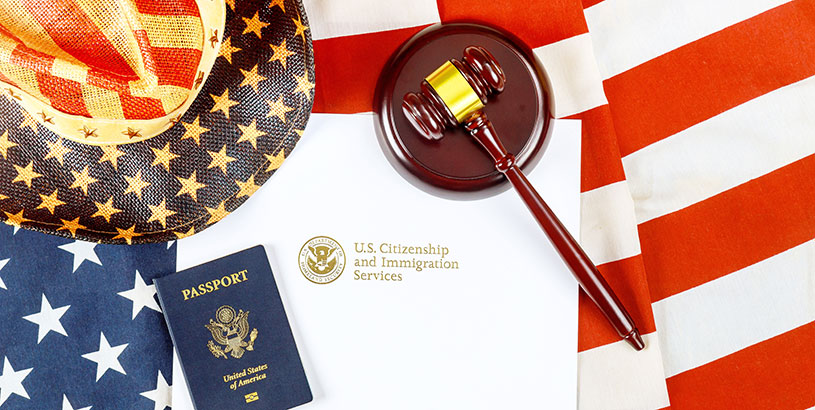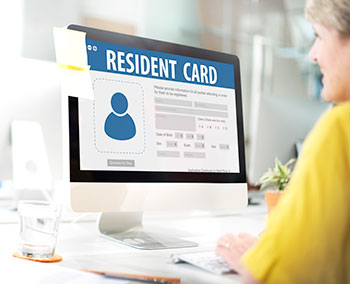Marriage-Based Green Cards

One of the most frequently asked questions from clients is “How can I get a green card?” The two most common pathways to becoming a green card holder are
1) getting sponsored by a spouse/ immediate family member, OR
2) getting an employer sponsorship.
The employment-based green card process is more challenging and much more difficult to obtain, as it requires a very particular set of skills. Additionally, applying for an employment-based green card is considerably more expensive, and the wait time is much longer. Fortunately, marriage-based green card options are usually available to foreign nationals who are married to
1) U.S. Citizens, OR
2) lawful permanent residents of the United States.
It will be easier to understand your green card options if you are familiar with the following immigration law terms.
 Visa bulletin: The U.S. State Department’s monthly publication that provides an updated waiting list of immigrant visas (green cards) that are subject to quotas based on categories and countries of origin
Visa bulletin: The U.S. State Department’s monthly publication that provides an updated waiting list of immigrant visas (green cards) that are subject to quotas based on categories and countries of origin
Immigrant visa: A visa that is issued to a foreign national allowing them to enter, work, and live permanently in the U.S.
Non-immigrant visa: A visa issued to enter the U.S. on a temporary basis (such as tourism, business, school, or work)
Priority date: The date that the United States Citizenship and Immigration Services (USCIS) receives your immigrant visa petition and puts you in the cue for a green card; after your application is approved, your priority date must be current before an immigrant visa is available
Lawful Permanent Resident: An immigration status that allows you to live/work in the U.S. (a green card)
Adjustment of Status: Adjusting your immigration status from a non-immigrant to a lawful permanent resident
Consular Processing: The process in which you apply for your immigrant visa at the U.S. Embassy/Consulate where you are currently living
K-1 visa: A specific non-immigrant visa that allows a fiancé of a U.S. Citizen to enter the United States, requiring them to marry within 90 days
Valid Immigration status: If your U.S. visa is valid and your authorized period of stay has not expired
If you are a foreign national who is married to a U.S. Citizen/ lawful permanent resident, your spouse may be able to petition for you if:
1) you and your U.S. spouse are in a valid, good faith, bona fide marriage,
2) your legal marriage is recognized by the U.S. government, and
3) your U.S. spouse can financially support your green card.
If you are living in the United States with your U.S. spouse, you can apply for your green card through a process known as “adjustment of status” to become a lawful permanent resident. There are a few conditions you must satisfy before you can apply to adjust your status and start the green card process:
1) you legally entered the United States with a visa or through a visa waiver program AND
2) you are still in a valid immigration status.
 However, if you are married to a U.S. Citizen and are no longer in status, there are some exceptions where your spouse can still petition for your green card.
However, if you are married to a U.S. Citizen and are no longer in status, there are some exceptions where your spouse can still petition for your green card.
Once you apply to adjust your status, it generally takes 7-9 months before you receive your “combo card”. Your combo card gives you work authorization and international travel authorization. It is advisable not to work in the U.S. or to leave the country until you receive your combo card. If you are approved, after about 18-24 months (estimating USCIS/ COVID-19 delays), you and your spouse will be scheduled for an interview at your local USCIS office. If you pass your interview, you will then receive your green card once it is available from the visa bulletin.
If you are living outside the United States, you can apply for your green card through “consular processing” at the U.S. Consulate in the country in which you are living. Once you pass your interview and have completed consular processing, you should receive your immigrant visa in about 18-24 months (estimating USCIS/ COVID-19 delays). At this point, you do not need a combo card as you already have an immigrant visa that allows you to enter the U.S. as a lawful permanent resident where you can live, work, and travel internationally.
It is even more important to start the green card process early if you are married to a U.S. permanent resident. While spouses of U.S. Citizens are exempt from the visa bulletin (meaning there is no quota or cap), the spouses of U.S. permanent residents are not. Once you have completed the green card process (whether family based or employment based), you still must wait for an immigrant visa to become available in your visa category and country of birth.
If you are living outside of the U.S. and are engaged to a U.S. Citizen, you may be eligible for a K-1 fiancé visa. The K-1 is a very specific, single-use, non-immigrant visa where you have 90 days to marry your U.S. Citizen fiancé after you enter the United States. Only fiancés of U.S. Citizens are eligible for a K-1 visa. Fiancés of lawful permanent residents are not. After you apply for a K-1 visa, if approved, it currently takes about 8-10 months before you can come to the U.S. and get married. Once you are in the U.S. and married, you then can apply to “adjust your status” with the USCIS. Current estimates show that it takes about 7-9 months for you to receive your combo card (which allows for work and travel).

Whether you apply for the K-1 or get married in your home country and wait to complete consular processing is a personal preference. You have to consider what is best for you individually and as a married couple. If your primary goal is to get to the United States more quickly, then a K-1 visa might be your best choice. Currently, it is taking about 8-10 months to get your K-1. Unfortunately, once you get to the U.S. using your K-1 visa, you cannot work or travel internationally until you receive your combo card. However, if you need to be able to work and travel internationally immediately upon arrival in the United States, you may prefer to get married in your home country and wait until you receive your immigrant visa from consular processing.
It is best to consult with an experienced immigration attorney to help you decide on your best immigration strategy before filing any immigration petition. Your lawyer can help you accurately complete the correct applications, submit the most appropriate supporting documents, and help you prepare for your interview. It is also important to find a compassionate attorney who you can trust and who can best guide you through this very complicated and emotional process.
 About the Author
About the Author
Attorney Seth Finberg is a 2005 graduate of the University of Georgia School of Law and is a member of the Georgia Bar and the American Immigration Lawyers Association (AILA). He is the owner and founder of Finberg Firm PLLC (located in Ft. Lauderdale, FL), and he represents clients nationwide in the areas of business- and family-based immigration. Mr. Finberg is an active member of the Miami Asylum Office Committee for AILA South and Central Florida, and he serves as a legal captain in pro bono clinics for Temporary Protected Status and Citizenship. Seth has been recognized for his outstanding pro bono service by the South Florida chapter of the American Immigration Lawyers Association, winning their 2021 Pro Bono Champion award. He can be reached by phone at (954) 249-6603 or by email at seth@finbergfirm.com at his Weston office currently, or at his new Hollywood office starting in February 2022.























